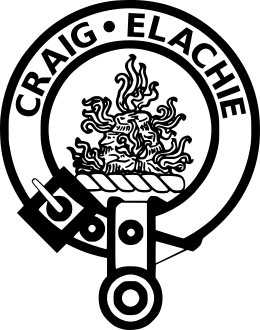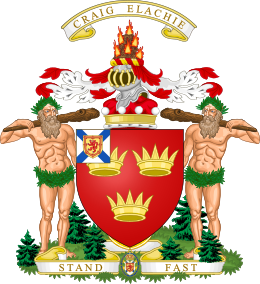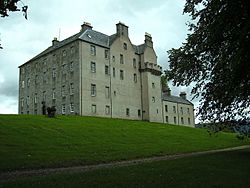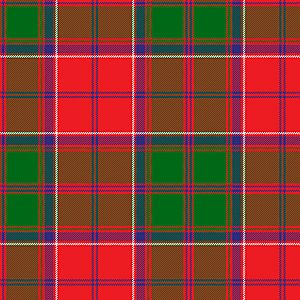Clan Grant facts for kids
Quick facts for kids Clan Grant |
|||
|---|---|---|---|
| Clann Grannd, Clann Chiarain, Clann Phàdraig, Sliochd an Amair | |||

Crest: An image of a burning hill. (The burning hill represents "Craig Elachie", the rallying point for the Grants. When signal fires were lit upon the summit of Craig Elachie, or "The Rock of Alarm", members of the clan would gather there in order to organise for an attack or defence.)
|
|||
| Motto | Stand Fast, Stand Sure | ||
| Slogan | "Stand Fast Craig Elachie!" | ||
| Profile | |||
| District | Strathspey, Glen Urquhart, Glenmoriston and Loch Ness. | ||
| Plant badge | Pine | ||
| Pipe music | Stand fast Craigellachie | ||
| Chief | |||
 |
|||
| The Rt. Hon. Sir Michael Grant of that Ilk | |||
| The 7th Lord Strathspey | |||
| Historic seat | Castle Grant | ||
|
|||
|
|||
|
|||
|
|||
Clan Grant is a famous Highland Scottish clan. A clan is like a large family group, often with a shared history and a chief. The Grants have a long and interesting history in Scotland.
Contents
- History of Clan Grant
- Castles of Clan Grant
- The Chief of Clan Grant
- See also
History of Clan Grant
Where the Grants Came From
The first Grants appeared in Scotland in the 1200s. They settled in an area called Stratherrick. One idea is that the Grant family came to Scotland from England with the Normans. Another story says they came from Norway.
A man named Sir Laurence le Grand was an important figure. He became the Sheriff of Inverness. He married the daughter of a powerful family, the Comyns.
Fighting for Scottish Freedom
During the Wars of Scottish Independence, the Grants were strong supporters of Scottish heroes like William Wallace. Two Grants, John and Randolph, were even captured in a battle in 1296.
Later, the Clan Grant bravely supported Robert the Bruce in his fight to become King of Scotland. Because of their loyalty, Robert the Bruce gave the Grants more land in Strathspey. This is where they became a very important Highland clan.
Clan stories say that the Grants, with help from the MacGregors, took Castle Grant from the Comyn Clan. This castle later became the main home of the Grant chiefs.
Growing Power in the 1500s
By the 1500s, Clan Grant was very powerful. Their chief, Sir Duncan Grant of Freuchie, inherited land in Speyside.
In 1535, James Grant, the 3rd Laird of Freuchie, was given the job of keeping order in Strathspey. This shows how much the King trusted the Grants.
The Grants were usually friends with the Clan Gordon. But towards the end of the 1500s, they started to disagree, especially about religion. The Grants were Protestant, and the Gordons were Catholic.
In 1586, the Earl of Huntly (chief of Clan Gordon) teamed up with other clans who often raided Grant lands. The Grants fought back, but they had some tough battles. By the late 1500s, Clan Grant was a major force in the Scottish Highlands.
The 1600s and Civil War
In 1613, King James VI of Scotland was upset with the Grant chief, John Grant of Freuchie. The King thought John was protecting outlaws from the Clan MacGregor. John sent one of the MacGregors to Edinburgh, but the King still fined him a lot of money.
During the Wars of the Three Kingdoms (a big civil war), Captain David Grant led his men to fight for the Covenanters in 1644. In 1645, the Clan Cameron raided Grant lands. The Grants chased them and defeated them in a battle.
In 1651, Sir James Grant, the 16th Chief, led his clan to fight for King Charles I (the Royalists). The Grants also joined with the Earl of Huntly to defeat the Clan Farquharson.
Later in the 1600s, some Grants supported King James II & VII, while others supported William of Orange. For example, the Grants of Glenmoriston fought for James at the Battle of Killiecrankie in 1689. But other Grants helped defeat James's supporters at the Battle of Cromdale in 1690.
The 1700s and Jacobite Risings
The 1715 Uprising
During the Jacobite rising of 1715, most of Clan Grant supported the British Government. However, the Laird of Grant pulled his forces back from a battle, which led to a government defeat. Soon after, the Grants helped take back Inverness from the Jacobites.
In 1715, the Grant clan had about 850 fighting men. At the Battle of Sheriffmuir in 1715, some Grants fought on both sides. The government forces won, and many Jacobites surrendered to General Grant.
The Black Watch
In 1725, six special Highland companies were formed to help the government keep order. One of these companies was from Clan Grant. In 1739, these companies became part of the famous Black Watch regiment.
The 1745 Uprising
In the Jacobite rising of 1745, the chief of Clan Grant again supported the British Government. But once more, he pulled his troops back from a battle, leading to another government defeat.
However, one part of the clan, the Grants of Glenmoriston, joined the Jacobites. They fought bravely at the Battle of Prestonpans in 1745 and helped the Jacobites win that day. They also fought at the famous Battle of Culloden in 1746. After Culloden, 84 Grants of Glenmoriston were captured and sent to Barbados to be sold as slaves. This was against the rules of surrender.
Highland Clearances and New Towns
The Clan Grant was one of the few clans that were not badly affected by the Highland Clearances. This was a time when many Scottish Highlanders were forced off their lands.
The "Good Sir James" Grant, who was chief from 1773 to 1811, built the town of Grantown-on-Spey. He did this to help his clansmen stay in Scotland and not have to move away. While other Highlanders were leaving, Sir James built schools, mills, factories, a hospital, and an orphanage. Grantown-on-Spey is a lasting reminder of his care for his clan.
Grant Regiments in the British Army
In the late 1700s, two army regiments were formed from Clan Grant members. The "Grant or Strathspey Fencibles" started in 1793, and the "97th" or "Strathspey Regiment" in 1794. These regiments served the British Army.
President Grant's Visit
In 1877, Ulysses S. Grant, who was a former President of the United States, visited Scotland. He was welcomed as a returning member of Clan Grant.
Clan Grant Today
The Duthil Old Parish Church and Churchyard is now a Clan Grant Centre. It has many memorials to important clan members, including Field Marshal Sir Patrick Grant.
In 2012, the chief of Clan Grant visited Winnipeg, Canada. He announced that Métis leader Cuthbert Grant was a member of the clan. This created a new branch of Clan Grant in Canada. Many Grant descendants came to meet Lord Strathspey.
Castles of Clan Grant


- Castle Grant was the main home of the Chief of Clan Grant.
- Urquhart Castle was owned by the Clan Grant from 1509 until 1912.
- Ballindalloch Castle has been owned by the Grants since 1499.
- Loch an Eilein Castle, near Aviemore, came to the Grants in 1567. It was attacked in 1690 but was successfully defended.
The Chief of Clan Grant
The current Chief of Clan Grant is The Rt Hon The Lord Strathspey (Sir Michael Grant of Grant). He is the 7th Baron Strathspey and the 34th traditional Clan chief of Clan Grant.
See also
- Siol Alpin
- Duthil Old Parish Church and Churchyard



